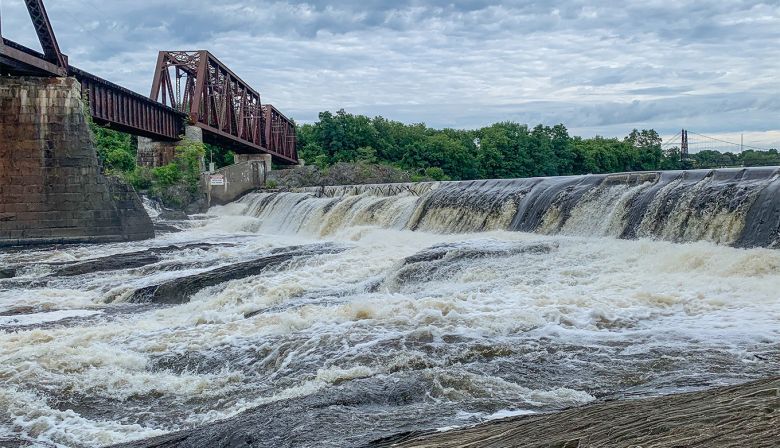The Wabanaki nations are often called “riverine” peoples because our interconnected waterways are central to our sustenance and cultures. We travel the rivers by canoe between our communities and sacred places, and, like the fish, harvest food from the rivers and their banks. The Kennebec River system connects us to the St. Lawrence, Androscoggin, Allagash, St. John, St. Croix, Aroostook, Sebasticook, Penobscot, and Machias rivers, as well as the open ocean.
Damming these rivers has been both a symptom and strategy of colonization. In spite of this, Wabanaki people can still portage around industrial obstructions. The fish cannot. For this reason we must do everything we can to ensure their access to the expansive northeastern river systems that sustain us all, and the Kennebec River is key to their ability to do so.
Today, Atlantic salmon are on the brink of extinction in this watershed and possibly across the entire continent because of four antiquated dams, all owned by Canadian-based energy giant Brookfield Renewable Partners. A dozen other once-abundant fish species are also unable to reach their historic territories, spawning and rearing habitats along the Kennebec and its tributaries.
The dams blocking salmon’s passage to critical habitat in the Sandy River are Waterville’s Hydro Kennebec and Lockwood dams, the Weston dam near Skowhegan, and the Shawmut dam between them, which is currently under review for relicensing through the Federal Energy Regulatory Commission (FERC).
Shawmut’s relicensing negotiations have persisted for years alongside federal processes to consider endangered species protection and the ecological consequences, economic benefits, and water quality impacts of small hydroelectric projects. During negotiations, relations between Brookfield and FERC have been described as “acrimonious,” as Brookfield’s privately conducted studies and data omission have caused tension.
As local residents and environmentalists raise awareness around fish habitat and population destruction, Brookfield has campaigned at town councils in the region, touting that dam removal will destroy local economies and plummet riverfront property values. Now on the defensive for all four of its Kennebec River projects, the corporation’s primary concern is sustaining assets — not aquatic life — in Maine.
As Wabanaki peoples, our own sustenance relies on the health of waterways and the fish that share them with us. Our primary concern and responsibility is protecting aquatic life, not corporate profits. Therefore, water protectors and allied environmentalists are calling for the removal of the four dams below the Sandy River.
For decades, dam owners and operators have offered their “best efforts and technologies” to mitigate habitat destruction and ensure fish passage, but progress has been negligible. Since a 1998 agreement that was supposed to result in a “rapid” and “comprehensive” settlement governing restoration for anadromous and catadromous fish species in the Kennebec, populations have continued to struggle.
Only 56 salmon made it beyond Waterville in 2019, compared to Atlantic salmon runs of hundreds of thousands in the pre-industrial Kennebec River. Now, the few dozen Atlantic salmon that are collected in Lockwood dam’s fish lift each year are loaded into a truck, transported upriver, and dumped into the Sandy. But most salmon no longer venture as far as Lockwood, which is the first dam they would encounter when returning to the Kennebec from the ocean.
For more information about what is at stake with the Kennebec River restoration, you can refer to the Natural Resources Council of Maine’s case study for removing dams from the Kennebec.
Alongside Atlantic salmon, restoration of American shad, blueback herring, alewife, and sea lamprey has “lagged” along the Kennebec, “primarily because of the lack of upstream fish passage.” About 60% of American shad and blueback herring historic spawning habitat is above Lockwood and Hydro Kennebec dams, and significant spawning habitat and population for alewife, sea lamprey, and American eel could be recovered through dam removal. Is the negligible amount of energy Brookfield’s dams produce for Maine worth sacrificing these species?
Wabanaki people and non-native environmentalists have led restoration efforts on the neighboring Penobscot River for twenty years. The Penobscot River Restoration Project has achieved two dam removals, unobstructed access to 100% of historic habitat for Atlantic and shortnose sturgeon and striped bass, access to 2,000 miles of Atlantic salmon habitat, cleaner waters, and improved health and ecology for native plants and animals in the river, estuary, and Gulf of Maine. Restoration of the Penobscot and the lower Kennebec River (the 1999 removal of the Edwards Dam in Augusta) are proof that dam removal has remarkable and resounding environmental outcomes.
From a Wabanaki perspective, we need a holistic approach to restore our aquatic relatives’ homes and futures. We have an opportunity to stand for the fish right now, and it may be our last. Dams are only one piece of the puzzle of river restoration, as out of state waste, mills, and landfill leachate dumping also poison fish, people, and water.
While removing dams is one step to restorative justice for fish, cleaning up the mess humans make of these waterways will require Wabanaki leadership. We must address the energy and waste industries polluting the river system, as well as the state policies and agencies that abet them.
